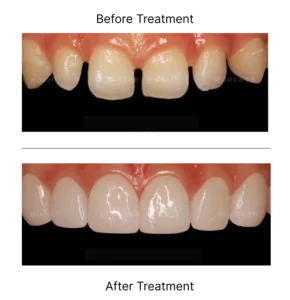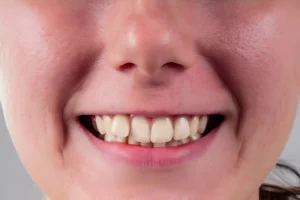Fill the void, embrace your smile makeover!
A gap between teeth, known as diastema, is a common dental concern. While some people find gaps charming or unique, others may feel self-conscious about their smile. Fortunately, modern dentistry offers various treatments to close these spaces and enhance your smile.
This article will explore the reasons behind spacing teeth and delve into various treatment methods to close these gaps, empowering you to make informed decisions about your smile.
The Root Cause of Diastema
There isn’t a single root cause behind spacing teeth. Instead, it can arise from a combination of genetic and environmental factors. Here are the most common causes:
1. Genetics
The size and shape of your jaw and teeth are largely determined by genetics. If your jaw is naturally larger than your teeth, spacing teeth can form. Family history of spacing teeth can also increase your chances of having them.
2. Missing teeth
If you lose a baby tooth prematurely, the surrounding teeth may shift, leaving a gap where permanent tooth should erupt.
3. Tongue thrusting
A habit of pushing your tongue against your teeth during swallowing can cause the teeth to move forward, creating gaps.
4. Labial frenum
A thick or tight labial frenum, the tissue connecting your lip to your gum, can push your front teeth apart.
5. Gum disease
In severe cases of gum disease, the gums and bone supporting the teeth can deteriorate, leading to lose teeth and gaps.
Why Close Gaps Between Teeth?
While gaps can add character to a smile, there are also functional reasons to consider closing spacing teeth with orthodontic treatment.
1. Gum Health
Gaps can leave gums exposed, making them more vulnerable to injury from chewing hard foods. This vulnerability can increase the risk of gum disease, which can eventually lead to lose or lost teeth. If gum disease is causing spacing teeth, it needs to be treated before orthodontic work begins. Your orthodontist can assess your situation and determine the best course of action.
2. Oral Hygiene
Gaps can make it harder to remove plaque effectively, leading to bad breath and tooth decay. Periodontal disease or serious gum infection is also more likely to develop in areas with exposed gums.
3. Aesthetics
Ultimately, the decision to close spacing teeth comes down to personal preference. Some people simply don’t like the way gaps look and feel self-conscious about them. Orthodontic treatment can create a more uniform smile for those who desire it.
Spacing Teeth – Treatment Options
1. Braces
Braces gradually shift teeth together by applying tension, closing gaps over time. They’re suitable for small or large gaps, including those caused by missing teeth. Braces benefit overall mouth alignment and come in various types:
- Traditional metal braces
- Ceramic
- Lingual
- Self-ligating
- Invisalign
Invisalign uses removable aligners and is an alternative for minor gaps or discreet spacing teeth treatment. Although convenient for eating and brushing, Invisalign is more expensive and may be less comfortable than traditional braces.
2. Veneers
Veneers are custom-made thin ceramic shells designed to fit over the front surface of teeth. They serve as a great choice for closing larger gaps, enhancing both the appearance of the smile and concealing spaces. One advantage is that veneers are stain-resistant and can be matched to the natural colour of your teeth. With proper care, veneers provide longer durability and can last for approximately 10-15 years.
Types of veneers include:
- Porcelain veneers
- Composite veneers
This procedure involves the removal of some amount of enamel for placement. However, good oral hygiene is important to prevent surrounding teeth from looking stained next to the veneers.
3. Dental Bonding:
Dental bonding is a cosmetic procedure that offers a simple fix to effectively close small gaps between teeth. During the procedure, a tooth-coloured resin material is applied to the teeth and sculpted to fill in the space. A special light then hardens the resin, seamlessly blending it with your natural teeth for a smooth and uniform appearance.
While dental bonding can sometimes chip, stain, and may need replacement every 5-10 years, it offers a more affordable solution compared to veneers.
4. Dental Implants:
For a more permanent solution, dental implants offer a realistic replacement. This treatment involves surgically placing an artificial root into your jawbone to act like a natural tooth root. After healing, your dentist attaches a custom-made crown to the implant, creating a complete and functional tooth.
Since they involve oral surgery, it could be a significant investment. The entire process, including healing time, can take several months. However, with proper care, dental implants can last more than 15 years, serving as a long-term solution.
5. Frenectomy
If your frenum or the small band of tissue that connects your upper lip to your gums is too large or attached too low on your gums, it can pull your teeth apart, resulting in a wide gap between your two front teeth.
This condition can be fixed with a simple surgery called a frenectomy. Your dentist will gently remove a small part of the frenum, relieving the tension and allowing your teeth to come closer together.
Which Treatment Option Is Right for You?
A dentist can help you decide on your treatment plan while considering the below factors:
- Cause of the gap: Understanding the underlying cause of the gap is essential for choosing the right treatment and preventing future gaps. Your dentist will first try to diagnose this cause.
- Severity of the gap: The size and location of the gap will influence the most suitable treatment option. Smaller gaps may require fewer complex treatments, while larger or multiple gaps might necessitate a more comprehensive approach.
- Your age: Certain treatments, like braces, may be more suitable for younger patients with developing teeth. Your age will be a factor in your dentist’s recommendations.
- Your lifestyle: Considering your daily routine and the amount of time you’re willing to dedicate to treatment will be valuable in choosing the option that best suits your needs and preferences.
- Budget: Spacing teeth treatment costs can vary depending on the complexity of the case, the chosen method, and your dentist’s fees.
Having a gap between your teeth doesn’t have to hold you back from a confident smile. Several effective and safe treatment options are available to address spacing and create a more aesthetically pleasing smile. By considering the factors mentioned above, exploring the different treatment methods, and discussing your concerns with a qualified dentist, you can find the ideal solution to achieve your desired smile goals.
Gaps be Gone! Straighten Your Smile at Simply Braces
At Simply Braces, we’re passionate about creating confident smiles through exceptional orthodontic care. We specialise in closing gaps between teeth and offer a variety of treatment options to address all your orthodontic needs like . We believe orthodontic treatment should be accessible and affordable, empowering individuals of all ages to achieve a healthier, happier smile.
We understand that a gap between teeth can impact more than just your smile. They can impact your self-esteem and confidence. Our dedicated team of professionals will work closely with you to find the perfect treatment plan, using the latest technology and techniques to ensure a comfortable and successful experience.
Take the first step towards a brighter, more confident you! Schedule a consultation with Simply Braces today.









